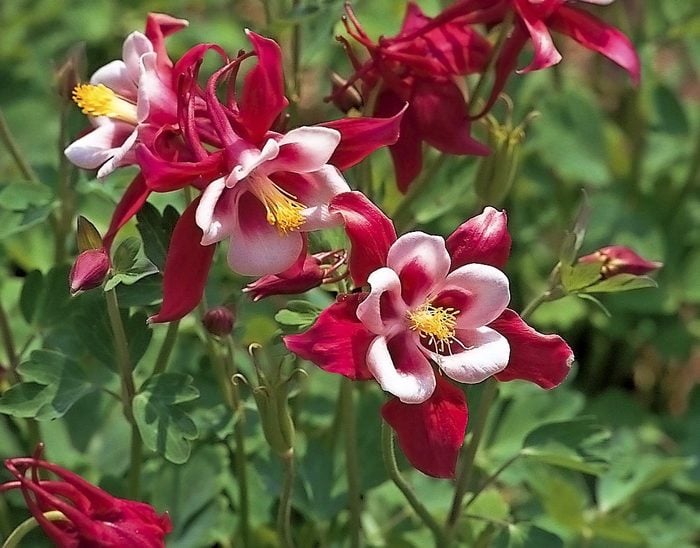
It’s a commonly brandished statistic: “Purple martins eat 2,000 mosquitoes a day!” We admit, it sounds lovely. Who wouldn’t want a bird in their backyard that’s a mosquito-eating machine? But given all the hullaballoo about purple martins and those nasty, buzzy insects, we felt the need to dig deeper. Do purple martins eat mosquitoes? We asked an expert, and here’s what we found out.
Learn which birds are known for eating insects.
Do Purple Martins Eat Mosquitoes?

Robyn Bailey, project leader at Cornell Lab of Ornithology’s NestWatch, sets the record straight for us: purple martins do not, in fact, regularly eat mosquitoes. There are several reasons that stat is wrong. As she points out, purple martins are out hunting for food during the day, while mosquitoes emerge during the evening. There isn’t much overlap in their schedules, and it certainly isn’t enough for the birds to eat thousands of them!
Psst—we found 8 mosquito-repelling plants you need in your backyard ASAP.
Furthermore, purple martins are looking for food in places other than where mosquitoes lurk. “Purple martins are feeding up high in the sky, out in the open,” Robyn explains. “Mosquitoes are closer to the ground, where their prey species live.”
If they’re not eating mosquitoes, what do they eat? Robyn says one Oklahoma study found purple martins eat invasive red fire ants, a notorious pest in the South and Midwest. She says they also eat termites and beetles, things people wouldn’t want in their homes, in addition to dragonflies, damselflies and other insects.
These are the 8 types of swallow birds you should know.
Fantastic! you think. If I can attract purple martins to my yard, I’ll never have a termite or invasive red fire ant problem. Not so fast. Robyn points out that while purple martins can eat bad bugs, it’s highly unlikely that their presence would eliminate a problem or prevent one from occurring. “They’re not specializing on those things,” she says, “so that’s not to say if you put up a purple martin colony, you’ll suddenly have no pests in your yard.”
Do hummingbirds eat mosquitoes? Here’s what you should know.
Benefits of Attracting Purple Martins

With all that said, there’s still good reason to want purple martins around. Robyn notes that the population is in decline, so any efforts to help are meaningful. “Having them in your yard would be of benefit to the bird,” she explains. “If you’re interested in helping species in conservation decline in your region, you can accomplish that by attracting purple martins.”
As Robyn also mentions, they’re beautiful birds. And if you can invite them to nest in your yard by putting up a purple martin house or a gourd array, you just might be the envy of all your birder friends. “They’re a bit of work [to attract], which is why I said it’s a bit of a ‘status’ thing to say you have purple martins!” she laughs.
Keep in mind that these swallows like to nest in open areas near water, so if you live somewhere that doesn’t feature those things, you might not be able to bring them in. But there are plenty of other birds you can invite to nest in your yard, like tree swallows, bluebirds, robins, wrens and chickadees. And no matter whether they’re nesting in your yard or swooping over a lake, there’s always cause to admire purple martins.
Next, learn how to turn a gourd into a birdhouse.
As the calendar flips to January, the first signs of spring begin to show. One of those signs is the January birth flower, snowdrops. These delicate flowers are an early blooming spring flower, and sometimes they’ll poke out even when snow is on the ground. The second January birth flower is carnations, which are one of the most popular fresh cut flowers.
Snowdrops and carnations signal that spring is on its way, and they make beautiful gifts for January birthdays.
If you’re not celebrating a birthday in January, we have you covered with birth flower gift guides for the rest of the year: February, March, April, May, June, July, August, September, October, November and December.
What Are the January Birth Flowers?

January’s birth flowers are the snowdrop and carnation. Snowdrops (Galanthus) bloom in late winter or early spring. They’re known by their shrinking white bell-shaped flowers and bright green leaves. These delicate white flowers are low-maintenance and add beauty to natural gardens, under deciduous trees and shrubs when they’re scattered throughout. Snowdrops are one of the best deer-resistant bulbs for spring blooms.
Carnations (Dianthus caryophyllus) are one of the most popular fresh-cut flowers in the world. In fact, they’re the second most popular cut flower after roses, which are the June birth flower. Carnation flowers have delicate, ruffled edges and come in natural colors of pink, white, red, yellow and scarlet. They’re easy to grow, easy to care for and look beautiful in fresh-cut arrangements and gardens. If you’ve never tried growing them in your garden before, now’s the time! They produce lots of flowers with little maintenance required.
What Are the Meanings of January’s Birth Flowers?

Both of the January birth flowers symbolize love and remembrance, but they also carry their own unique meanings. Carnations are known as “flowers of the gods” in Greek. As with other birth flowers, different-colored carnations feature different meanings:
- White carnations symbolize innocence and purity
- Pink carnations symbolize gratitude and affection
- Light red carnations symbolize admiration
- Dark red carnations symbolize love and affection
Snowdrops, which usually bloom in the late winter, signify hope and beauty. Because of their bright white color, snowdrops also symbolize innocence and purity.
Now that you know more about January’s birth flowers and they’re meanings, take a look at these carnation- and snowdrop-inspired birthday gifts. From fresh flowers to scented candles and grow-your-own flower kits, these gifts are guaranteed to bring joy to everyone on your January birthday list.
January Birth Flower Gift Guide
Carnation Flower Cake
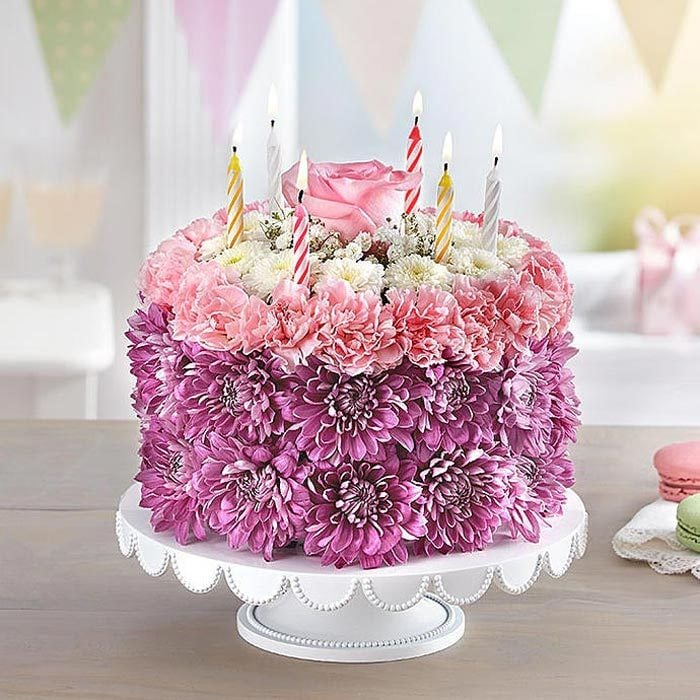
Why send a bouquet of flowers when you can send a fresh flower cake? This decorative birthday cake is made of fresh carnations and other beautiful blooms, making it the perfect table centerpiece for your loved one to enjoy all month long. Don’t be fooled, this flower cake is only for decoration, not for eating.
Art Print

The January birthstone (garnet) and the January birth flower come to life in this eye-catching digital art print. It’s the perfect idea for any last-minute shoppers. Simply download the digital file and print at home or your local print shop. Add a frame for a quick and beautiful birthday gift that goes a long way.
Carnation Birth Flower Throw Pillow

Celebrate a January birthday with this birth flower throw pillow. One side features a colorful watercolor image of a carnation, along with its name and meanings. And the other side features a beautiful pattern of carnations. Loved ones will enjoy this decoration all year long.
Mrs. Meyers Snowdrop Scented Candle

These Mrs. Meyers Snowdrop candles will transport anyone to a winter wonderland. The candle features notes of orange, mandarin, white grapefruit and iced petunia, along with notes of poinsettia, white jasmine tea and a hint of wood. Grab the snowdrop scent in other Mrs. Meyers products for a one-of-a-kind gift.
January Birth Flower Jewelry Dish

A hand-drawn carnation flower is imprinted on this colorful ceramic dish that can be used for jewelry, small trinkets or alone as a decoration. On the bottom of each unique dish is the name of the month and the flower stamped into the clay, along with the flower’s meaning.
Carnation Flower Necklace

This engraved carnation flower necklace is thoughtfully packaged on a custom card featuring the month, name of the flower and attributes associated with the January birth flower. Choose from a gold or silver finish, depending on the preference of your loved one. This is a great gift to mail that special someone.
Flower Grow Kit

This birth month flower grow kit includes everything your loved one needs to grow their own carnations at home: seeds, a glass bottle to grow them in, soil-less growing material, instructions and information about what the January birth flower symbolizes. This gift will (literally) bloom right before their eyes.
Carnation Tea Towels

If the January birthday on your list also happens to love spending time in the kitchen, then they’ll enjoy these carnation tea towels. This gift features a watercolor illustration of carnations and its meaning. Plus, it adds an extra dose of color and beauty to kitchens in the winter months.
Carnation Mug

A personalized coffee cup makes a heartfelt gift—especially when it’s as adorable as this carnation mug. This January birth flower mug comes in two colorways and sizes. Customize it with your loved one’s name or a special phrase for an added layer of thoughtfulness.
Birth Flower Robe

Enjoy some R&R in this stylish and comfortable birth flower robe. Adorned with artwork of carnations on a colorfully bright background, this light robe is made of sustainably sourced, biodegradable material. The robe comes in a printed fabric drawstring gift bag—which means you don’t need to dig for gift wrap.
December is the most magical time of year as holidays and traditions are in full bloom, as are the December birth flowers: holly and narcissus—specifically the paperwhite. Although they’re different from each other (holly isn’t a flower at all, it’s an evergreen shrub) they’re pretty winter plants for decorating your home. Holly and narcissus aren’t just festive winter flowers, they’re a beautiful focus of gifts for December birthdays on your list.
Here’s everything you need to know about the December birth flower and a list of birthday gift ideas inspired by holly and narcissus. If you’re not celebrating a birthday in December, we’ve curated birth flower gift guides for January, February, March, April, May, June, July, August, September, October and November too.
What Are December’s Birth Flowers?

December has two birth flowers: holly and paperwhite narcissus.
Technically, holly isn’t a flower at all; it’s a plant with small red berries. This holiday favorite is a popular winter decoration, which is just one fascinating fact about holly. Its origin dates back to when Romans decorated their homes with holly during the celebration of Saturnalia, which was observed in December prior to the winter solstice. In Christianity, holly leaves represent the crown of thorns and the red berries symbolize Christ’s blood. And in England, some of the first Christmas trees were holly trees, not fir trees that are commonly used today.
Holly berries, leaves and bark are not safe for humans and most pets to consume because they contain a mildly poisonous compound called theobromine, a substance similar to caffeine. Birds, however, can handle the toxicity of the berries—making holly an important winter food source for birds that eat berries.
The second December flower is narcissus. While there are many types of flowers in the genus narcissus—including the daffodil, which is the March birth flower—the paperwhite narcissus blooms in the winter. The flowers come in a variety of colors including white, yellow and orange. If you’re tending to paperwhites the researchers at Cornell University found that adding a shot of gin or vodka to water stops them from drooping as they grow taller.
What Are the Meanings of December’s Birth Flowers?

For those with December birthdays, holly symbolizes happiness and hope. Holly also symbolizes protection. Historically, members of the high-ranking class in ancient Celtic cultures (aka druids) believed holly had protective qualities, and cutting down a holly bush caused bad luck. According to the Holly Society, holly bushes also protect nearby surroundings from lightning strikes: “We now know that the spines on the distinctively-shaped holly leaves can act as miniature lightning conductors, thereby protecting the tree and other nearby objects.”
The paperwhite narcissus symbolizes good wishes, faithfulness and respect. They’re also associated with purity, sweetness and complicity.
Now that you know more about December’s birth flowers, take a look at these holly- and narcissus-inspired gifts. From decorations, to jewelry and apparel, these gifts will delight anyone on your list (and double as Christmas gifts).
December Birth Flower Gift Guide
Holly and Berries Ornament

December is the perfect time to gift a holly and berries ornament. This handmade, porcelain ornament features original artwork of holly leaves and berries. Personalize it with the name of your choice for a special touch. It can be enjoyed on your loved one’s holiday tree and as a decorative piece during the year.
Narcissus Bracelet

Celebrate a December birthday with this gold narcissus bracelet. The charm features a colorful illustration of narcissus flowers in bloom on one side and an engraved message of your choice on the other. Your thoughtfulness will be remembered every time this bracelet is worn.
Holly Notepad

This holly notepad is a thoughtful gift as it can be personalized with the name of your choice. Select your finishing touches, including if you want a magnetic back, lined or un-lined paper and ink color of choice. It’s perfect for loved ones who are obsessed with keeping their grocery lists and reminders organized and at their finger tips.
Narcissus Art Print

This beautiful illustration of narcissus includes hand drawn flowers, the flower name and the birth month. Customize the size and background, which comes in blue and white. Plus, you can customize by adding your loved one’s name or another personal touch that’ll make them smile. Note: The print doesn’t include a frame.
Holly Wreath

Gift this gorgeous holly wreath adorned with small red berries that also doubles as holiday decor. This versatile wreath can hang on the wall or sit as a table centerpiece. Add a candle and you’re good to go!
Holly Bottle Art

This birthday flower bottle art decoration is a fresh take on the classic message in a bottle. Only this time, it’s a tiny flower and special birthday wish of “Happiness & Hope” inspired by holly that’s in the bottle. December birthdays will treasure this gift wherever they decide to put it.
Holly Necklace

Those with December birthdays will love this gold holly necklace with an illustration of the winter flower on an engraved charm. This delicate jewelry piece is packaged with a custom card that includes information about holly’s meaning. Gift recipients will enjoy wearing this holly necklace year round.
Holly Scarf

This birth month flower scarf is adorned with watercolor illustrations of holly. It’s a great gift to mail because it comes wrapped in a custom box featuring the birth flower’s scientific name, the affectionate traits that are associated with it and a colorful print of the bloom.
Birth Flower Sticker

If you’re looking for a little something to celebrate a coworker, friend or family member, this vinyl sticker goes a long way. Inspired by December’s birth flowers, this sticker features a colorful illustration of both holly and narcissus.
Narcissus Earrings
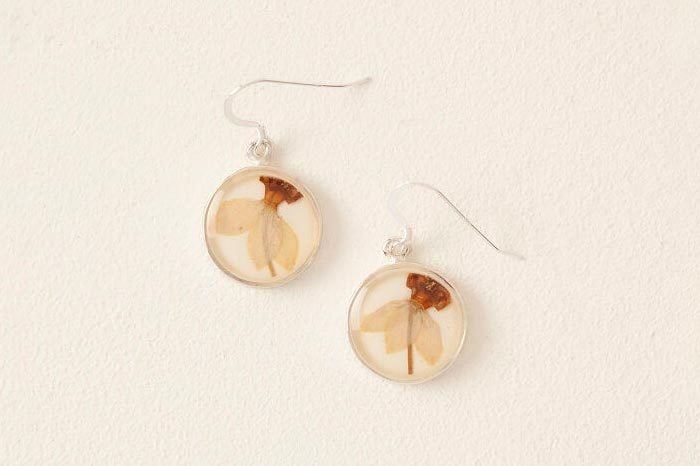
This lovely pair of handmade birth flower earrings is a thoughtful gift for your loved ones. A real narcissus flower is coated in a small resin pendant to preserve its beauty, hung on sterling silver ear wires. These earrings can be worn any time of year.
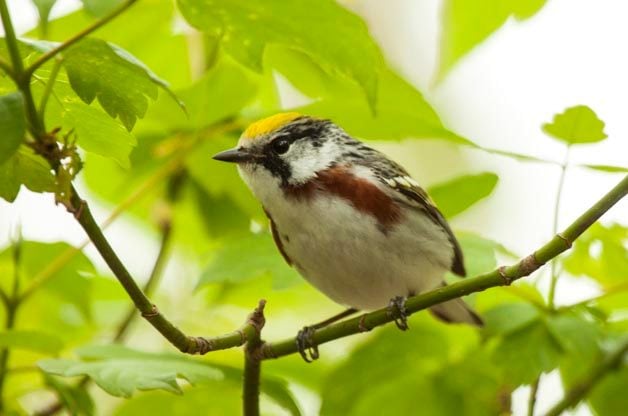
Unfortunately, sometimes birds run into our windows — that’s why “bird strike window” is a common Internet search. And it can be much worse during spring and fall migration. It’s never fun to see our feathered friends suffering after these window strikes but, luckily, there are some things that you can do to help prevent bird strikes on windows.
Psst—check out 5 ways to create a bird-safe backyard.
Birds fly into a window for a couple different reasons. Sometimes they can see straight through your house out another window and think that they can fly right through. Other times, the reflection off the window plays a similar trick on them. According to the American Bird Conservancy an average of two birds are killed at each U.S. home every year by window strikes. Here are a few ways that you can help reduce this problem at your house — and you’ll never have to worry about Googling “bird strike window” again.
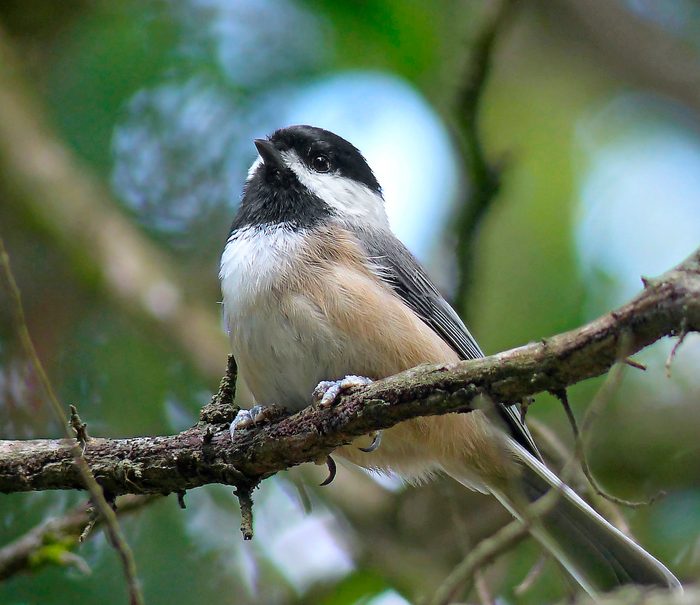
- Use these products that the American Bird Conservancy recommends on your windows to break up the reflection and make the windows stand out to birds.
- Hang reflective items on the outside of the window. This will get the birds attention and direct them away from the window.
- Draw a pattern on the outside of your windows using a white paint marker.
- Place bird feeders within 3 feet or outside of 10 feet of all windows.
- If you’ve tried these things and you’re still getting window strikes, put screens on all of your windows.
Here’s expert advice on how to help a bird that flew into a window.
How To Keep Hummingbirds From Hitting Windows

It’s important to stop hummingbirds from hitting windows. Birding experts Kenn and Kimberly Kaufman say, “Along with roaming cats, window strikes are among the leading causes of bird deaths.” And, unfortunately, hummingbirds aren’t immune.
They say because glass reflects the outside scenery, hummingbirds think they can fly through. Like with other birds, to prevent strikes, you must break up the reflection on the outside of the glass.
Growing awareness of window strikes has led to several fantastic products coming onto the market. Kenn and Kimberly say, “We have tried BirdTape from the American Bird Conservancy and found it to be highly effective. For more info, visit abcbirdtape.org.”
They note that decals pasted on the inside of windows (hawk silhouettes are a common choice) are not enough to protect birds, and you should take other measures to protect birds.
Reader Tips to Prevent Window Strikes
Birds & Blooms readers share the clever ways they keep birds safe from reflective glass.
“My house is on a river with a large picture window. We had regular window strikes until I learned about bird netting and stapled a sheet of it onto the molding. It isn’t the prettiest, but we haven’t had a bird hit the window in two years.” – Kevin Maurice, Des Moines, Iowa
“Bird’s Eye View brand window deflectors are affordable and work well.” – Alison Jaggers, Akron, Ohio

“I hang brightly colored suncatchers in my windows. The light keeps the birds away.” – Carol Sanderson, Newington, Connecticut
“I installed strings over my large windows, along with wind chimes and window stickers.” Janet Lussier, Coventry, Vermont
“I place seasonal decorative decals on the outside of my sunroom windows, using large snowflakes in winter, hummingbirds in spring and summer, and leaves in autumn.” Pam Tomka, Washington, Illinois
“Draw on your windows with a bar of soap. I simply draw X’s, but you can get more creative. The best part is that the soap washes off easily.” Robin Roeben Conway, South Carolina
Next: Have you noticed a bird pecking at your car mirror? Here’s why — and how to stop it.
What Are Horned Melons?

Horned melons are related to fruit like musk melons and cucumbers. Plants produce an orange colored fruit that has rough, spiky outer skin. Don’t be intimidated—according to Taste of Home, the fruit inside is sweet, tasting somewhat like a kiwi or a banana but a bit more citrusy. To eat a horned melon, slice the fruit in half, scoop out the fruit and serve.
Check out our favorite summer fruits and vegetables to grow.
Other Names for Horned Melons
This African native goes by quite a few names. The most common other name is jelly melons, but they’re also called African horned cucumber, hedged gourds or Kiwano melons.
Try these 5 tasty ways to deal with zucchini overload.
How to Grow Horned Melons

First, consider your location—they don’t do well in cold temperatures. They’re best grown in zones 9 to 11, but it is possible to grow them anywhere with a growing season longer than 120 days. The seeds can be started indoors to extend your growing season.
Once you’re ready to move the seedlings outside, plant them in a spot with full sun and well-draining, slightly acidic soil. Be sure to provide a trellis or other structure for the plant to climb.
After it flowers, the plant will start growing fruits that look like small green cucumbers. They will slowly ripen into their orange color.
We found the top 10 dwarf fruit trees for small spaces.
Why Do Horned Melon Leaves Turn Brown?

Birds & Blooms reader Brittany Lawrence grew a horned melon in her backyard in Andover, New Jersey. She asked garden expert Melinda Myers, “I carefully water my horned melons once a week and protect them from rain the rest of the time. Why are the leaves starting to brown?”
Melinda: Evaluate the impact of the rain shield on your plants. Horned melons thrive in full sun, good air circulation and moist, well-draining soil. Weekly watering by hand may or may not be sufficient for this plant to thrive. Make sure to thoroughly water a wide area of soil next to and around the plants. Drought, stress or waterlogged soil can cause leaves to yellow and eventually turn brown. Several diseases that also result in brown spots can attack melons, squash, cucumbers and their relatives. The most common diseases include powdery mildew, downy mildew and several leaf spot diseases.
Next, learn how to store vegetables so they stay fresh longer.
Transform Your Yard With Shade Garden Ideas
It seems like every gardener has a pitiful patch that seems to be cursed with full to partial shade. Every year you plant something there, hoping that it will at least survive the summer, but it never does. We’ve heard these stories from readers for years, and we know shady spots can be a big challenge. That’s why we came up with a list of our all-time favorite shade perennials. They won’t just survive, they’ll thrive in shade. Our list is complete with everything you’ll need—gorgeous blooms, foliage, even a ground cover! Want more shade garden ideas? Give these annuals a try, too: fuchsia, begonia, caladium, torenia, monkeyflower, and coleus.
Columbine
Aquilegia, Zones 3 to 9
Carefree and consistent, columbine is a longtime favorite that stands up beautifully to shade. If you’ve ever thought about growing it, make this the year!
Why we love it: One of the easiest wildflowers to cultivate, it shines in both manicured gardens and wilder surroundings. And birds love it!
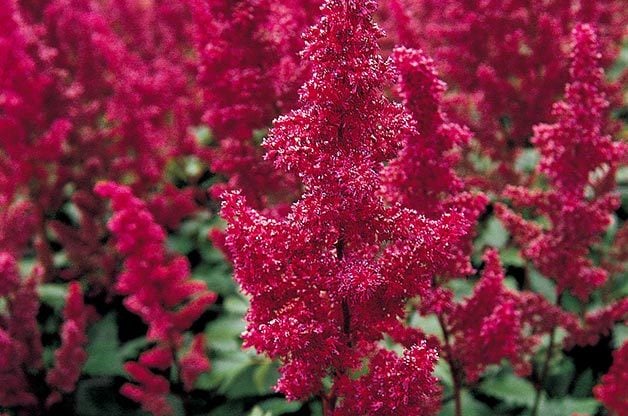
Astilbe
Astilbe spp., Zones 3 to 9
Similar in appearance to ferns, astilbe fits right into a shade garden. Its elegant foliage is a delight even when the white, pink, red or purple flowers are done blooming. Moist soil is a must to keep astilbe alive.
Why we love it: The 1- to 4-foot flower spikes are showstoppers. Because of its height, astilbe is best planted near the back of a flower bed, with a shorter plant, such as hosta, in front.
Grow New Guinea impatiens for more color in shade.
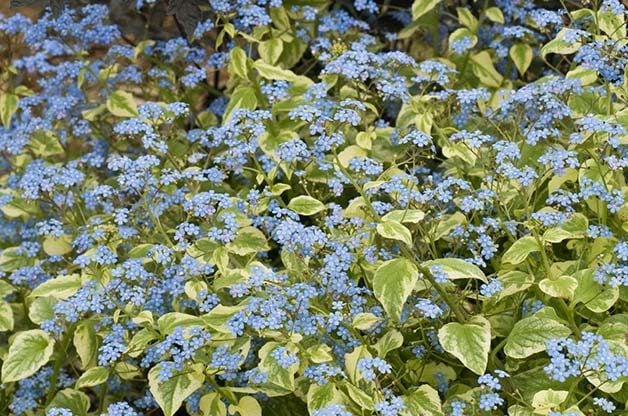
Brunnera
Brunnera macrophylla, Zones 3 to 8
Variety is the spice of any garden, and brunnera will bring that to your shady location. It features distinctive heart-shaped leaves and charming small blue blossoms.
Why we love it: Brunnera reaches about 12 to 18 inches in height and 18 to 24 inches in width, making it a natural to enhance borders or beds.
Discover more edging plants for multiple seasons of color.
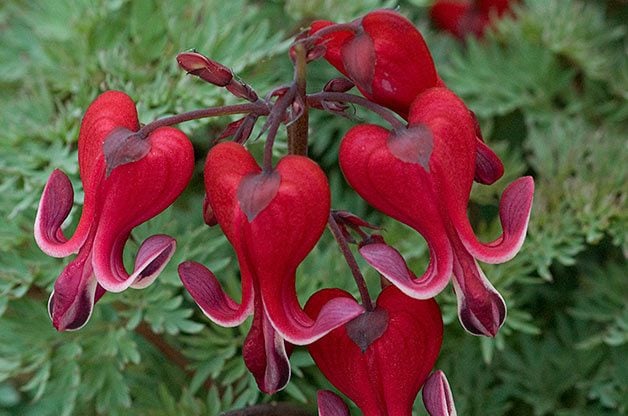
Bleeding Heart
Dicentra spectabilis, Zones 2 to 9
Try a fringed bleeding heart, like burning hearts. The delicate foliage and heart-shaped blooms make this one a captivating spring shade favorite. Just know that it’s an early bloomer, but fringed bleeding hearts hold their leaves and flower sporadically through summer.
Why we love it: Bleeding heart is self-seeding. Wait to cut it back, and you’ll see a spectacular show of blooms the next year.
Bleeding hearts are a good choice for gardening in tough areas — check out more plants for tricky locations.
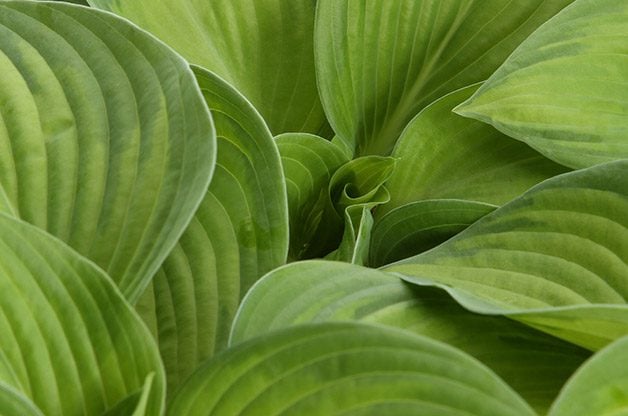
Hosta
Hosta, Zones 3 to 8
No “best of” shade list would be complete without hostas. This hardy plant is known for adding texture and color to shady areas. While some hostas tolerate sun, those grown in partial shade usually produce the best-looking and longest-lasting leaves.
Why we love it: Dense, leafy clumps make way for stems of blossoms that rise up to 3 feet above the prized foliage. There are so many varieties on the market chances are one or several will fit your garden.
Did you know? Hostas attract hummingbirds!
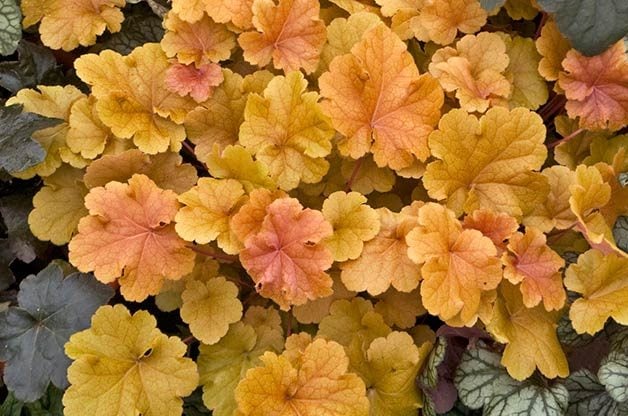
Coral Bells
Heuchera, Zones 3 to 9
Colorful foliage and spires of small blooms make coral bells a must for every list of shade garden ideas. The pretty blossoms emerge in late spring and last through early summer on 8- to 10-inch stems. Then the foliage steals the show, often changing colors in fall.
Why we love it: Coral bells will never bore you! The leaves come in a rainbow of colors from yellow-orange to deep purple. Hummingbirds love the flowers, too. Shown here is Christa in a cool peach color.
Need more shade plants? Check out these shrubs for shade gardens.
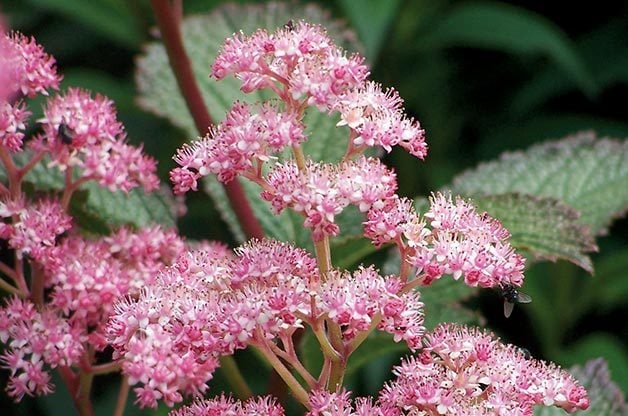
Rodgersia
Rodgersia spp.,Zones 5 to 8
You’ll love choosing among the white, rose-pink and red blooms. This pretty plant needs some space and moist soil, though. Rodgersia will rise above the rest in your shady space, growing 3 to 6 feet tall and 2 to 3 feet wide.
Why we love it: The large, boldly shaped leaves, which turn from green or bronze to reddish in fall, are almost as colorful as the blossoms.
What grass grows in shade? Plus, here’s why ferns are a foolproof pick for a shade garden.
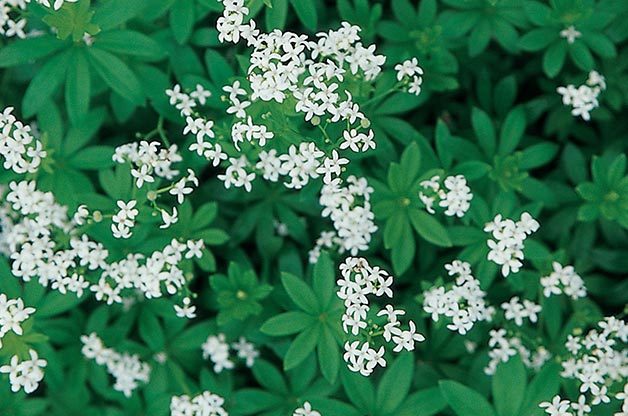
Sweet Woodruff
Galium odoratum, Zones 4 to 8
We’ve got you covered with shade garden ideas. Try this ground cover! It likes to be cool, so give it plenty of mulch. Sweet woodruff often spreads up to 2 feet, which means a couple of plants can go a long way.
Why we love it: The blooms may be tiny, but they’re irresistibly fragrant. Delicious-smelling white flowers appear in late spring.
You know about shade perennials, but what about vegetables? Here are some vegetables you can grow in shade.
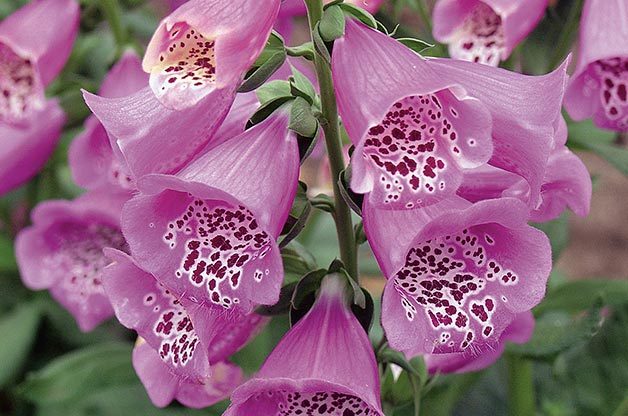
Foxglove
Digitalis, Zones 3 to 10
This one’s a real beauty. Depending on your location, foxglove is a biennial or short-lived perennial. Prepare to wait a year for the blooms to show; the reward will be flowers that are both fantastic and plentiful. Just one note of warning: Don’t ever ingest this plant, because some parts of it are poisonous.
Why we love it: Foxglove can reach a lofty 6 feet tall, with stalks full of bright, bell-shaped blossoms.
Find more backyard solutions with these low-maintenance landscaping ideas.
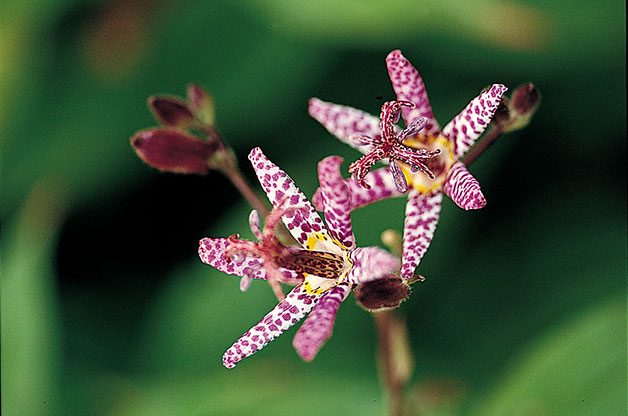
Toad Lily
Tricyrtis, Zones 4 to 9
With such stunning blooms, it’s surprising the toad lily is a shade fan. The orchidlike blossoms in white, mauve and yellow will definitely grab attention. Perfect for a shady woodland, it grows 1 to 2 feet wide and 1 to 3 feet tall.
Why we love it: The toad lily is easy to grow, drought tolerant and resistant to deer. The lovely blooms emerge just as the rest of the garden is starting to fade away for fall.
Next, check out the top 10 hummingbird plants that grow in shade.
What Does a Violet Green Swallow Look Like?

Like other members of the swallow family, the violet green swallow’s plumage is shiny and striking. Males are green with brownish-purple wings and a purple rump, and they have a white belly and a white face. Green feathers cover the top of their head.
Females are similarly colored, if “muddier”; while they have some green feathers, their bellies are streaked with gray-brown and their heads are almost entirely brown as well. Juveniles follow the same plumage pattern as the males, but where males would have green or purple feathers, they have dark brown.
Do swallow sightings have special meaning?
“I spent a long weekend in Glenwood Springs, Colorado, with my family over the Fourth of July weekend. I spotted this beautiful violet green swallow (above) on two of my morning walks, perching in the same tree each time. The light hit him just right on this morning to appreciate his full coloration,” says Birds & Blooms reader Amy Atwell.
Cliff swallow vs barn swallow: spot the differences.
Nest and Eggs

Similar to the tree swallow, violet green swallows are cavity nesters. They can nest in cliffs, but they’ll also use dead trees, old woodpecker holes or nest boxes like the ones bluebirds use. They will sometimes nest in groups of up to 25 pairs.
These swallows build cup-style nests that can take up to 20 days to complete. A typical clutch consists of 4 to 6 white eggs, and parents will raise one, or occasionally two, broods per season. The mother bird does most of the feeding, but the father helps, too. Learn more about swallow nesting habits.
Violet Green Swallow Range

Birders in the west who live near water or wooded areas have the best chance of spotting one of these glimmering green birds. During their breeding season, they’re commonly found almost everywhere west of the Dakotas. Their range stretches up from Washington into Canada and even into Alaska.
“I am a wildlife photographer and I recently moved to the Oregon Coast. A family of violet green swallows (above) set up home in one of our nest boxes, and I took the opportunity to add another bird portrait to to my collection. The parents raised all four chicks successfully,” says Birds & Blooms reader Rowland Willis.
Discover fascinating facts about barn swallows.
What Do Violet Green Swallows Eat?
Similarly to other swallows, this species eats bugs — and plenty of them. They swoop and soar through the air to snack on flies, beetles, wasps and other flying insects. While you might not spot these birds at feeders, if you have a buggy backyard, you might be able to bring them in. Grow native plants that bees and beneficial insects love to attract more bug-catching swallows.
Next, discover how to identify purple martins — and find out how to attract them with a purple martin birdhouse.
Replanting Flowers: The Basics

“Why didn’t I plant those daffodils beside the doorstep? Now I have to wait until fall to transplant!” The best ideas don’t always come to us when we want them to. Those coppery orange daylilies in your summer garden, for instance—they sure are showstoppers, but it’s a shame the blue veronicas are way over there. They would be glorious with the daylilies. We’ve all done it. No matter how much time we spend figuring out where to plant what, we always make mistakes. We think we have it just right—until the plants come into bloom. Then all we can think of is replanting those flowers.
These are the best flowering perennials that bloom all summer.
It goes on all season, as plants grow and bloom and show us the error of our ways. Sometimes we’re off by a matter of inches, or sometimes many feet. Don’t live in regret, though. The next time you think, Why didn’t I plant that here instead of there? just dig right in and fix it on the spot. I call it designing with a shovel. Go ahead and move those bright Asiatic lilies behind the cool blue campanulas, or partnered the deep red rose with the pure white Shasta daisies.
Learn how to plant shrubs and bushes.
Which Flowers and Perennials Can You Transplant?
All of these plants, plus many more, can be transplanted in bud or bloom:
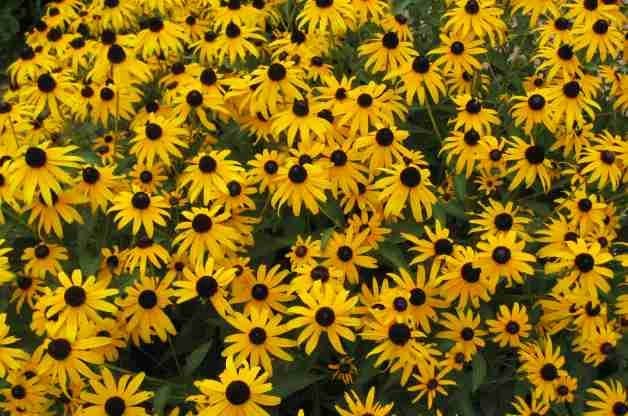
- agastache
- artemisia
- Asiatic lilies
- Monch aster
- bee balm
- bulbs
- Goldsturm black-eyed Susan
- cardinal flower
- campanulas
- thread-leaved coreopsis
- daylilies
- feverfew
- liatris
- mums
- obedient plant
- phlox
- coneflower
- sedum
- Shasta daisy
- Siberian iris
- veronica
- yarrow
Dividing perennials: Here’s how, when and why you should divide plants.
When Is the Best Time to Transplant Perennials?
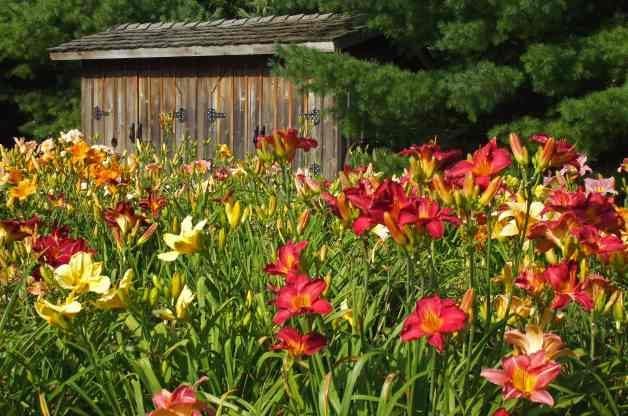
Sure, you could wait to transplant misplaced perennials and bulbs until fall, when plants are done blooming, or early spring, when they’re just getting growing. But why wait? You can move many perennials—anything with fibrous roots—and just about any bulb while they’re in bud or even in bloom.
For best results, transplant on a cloudy day if you can so the plant won’t lose moisture to the sun from its leaves. If you can’t wait for the weather, transplant in late afternoon. That way the plant can begin settling in without being stressed by a day of sun.
Of course, the most important thing you’ll need for designing by shovel is something you already have—water. No matter how careful you are when digging, you’re going to slice through some roots, and roots bring the plant water. Until they settle themselves in the new spot, the plant won’t be able to get enough water to keep it from wilting. The solution? Watering at every step of the way.
Learn how to overwinter non-hardy bulbs and tropical plants.
How to Transplant Perennials

Start by giving the plant you intend to move a good drink so it’ll be well-hydrated by the time you transplant. Decide exactly where the plant is going to go. Dig a hole—about 10 inches across and a shovel-blade deep is a good start. You can adjust it later.
Next, fill the hole with water and let it soak in. Fill it again and let it drain again. If the water still disappears within 20 minutes, do it a third time. The soil should be moist, not muddy. This extra moisture ensures the surrounding soil won’t wick away the water from your transplant.
Now you’re ready to begin moving operations. Dig all around the plant (or clump of bulbs), wider and deeper than you think you need to. For bulbs, dig at least 10 inches deep. For other perennials, you may need to go down only 6 to 8 inches. I use a drain spade—its longer, narrower blade is perfect.
Eyeball the size of the root-ball when you lift it. Then gently set the plant back in place. Check your new hole—is it big enough for the roots to fit, and deep enough so the plant will sit at its previous height? If yes, great! If not, just put some soil back in the bottom.
“Handle with care” is the motto when transporting the plant. Keep the soil around those roots as intact as you can, and be careful not to break stems or knock off buds. If your plant isn’t too big, simply carry it on the blade of your shovel to the new hole, supporting it with one hand. For larger plants, use a wheelbarrow. Slide the root-ball into the new hole, and turn the plant until you’re satisfied that its best face is forward. Fill the hole with soil and firm it down.
Water Well After Replanting Flowers

Next, more watering! Fill the hole with water again, but don’t wait for it to drain. Go ahead and finish filling in the hole with soil, and pat it down gently so that you don’t squish out all the oxygen, because roots need air as much as water. Supply temporary shade for the first day or two to help prevent wilting. An easy way to do this is to set a lawn chair over the plant. Check out the top 10 best rated garden hose options.
Think of your new transplant as a bouquet of cut flowers for the first week. It needs extra water until those new root hairs take hold, but water too much and you could drown it. If puddles stay on the surface for more than a few minutes, back off with the hose.
It’s amazing how quickly a transplant settles in, even if you move it at the peak of bloom. In as little as two to three days, your plant will look as if it’s been there forever—in exactly the right place.
Next, discover why fall is the perfect time to plant perennials.
When you’re at the garden center, the cost of plants can add up in a hurry. Before you know it, you’re spending $100, $200 and more on plants that you hope will work in your backyard. Beautiful and resilient plants don’t have to be a gamble, though, with these low maintenance perennials.
These plants will be back year after year, will save you money on watering (all are drought-tolerant!) and will eventually fill up a lot of space. So the next time you’re thinking about adding to your garden, stretch your dollar a little further and let our low maintenance, best-value perennial plant list be your guide.
Annuals vs. perennials — what is the difference?
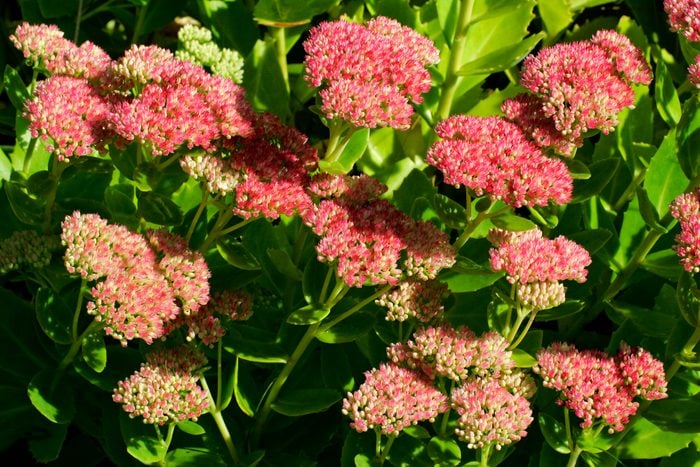
Sedum
(Sedum species, Zones 3 to 10)
You rarely have to worry about whether this one of our low maintenance perennials will come back each year. One of the most reliable growers around, sedum offers delightful color well into fall. The star-shaped blooms are a treat for butterflies, and fall-blooming varieties offer fuel to monarchs and other late fliers on their journey south.
Why we love it: It’s one of the first perennials to emerge in spring, and then it offers interesting foliage until it begins blooming from late summer through the end of fall.
Discover more easy perennials that anyone can grow.
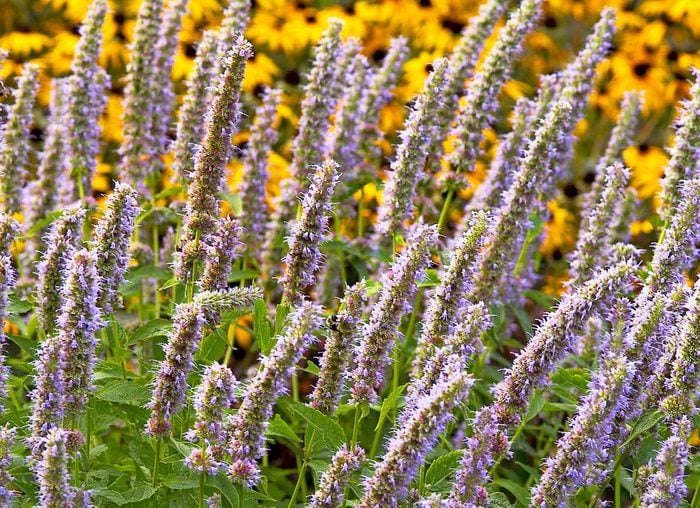
Agastache
(Agastache species, Zones 5 to 11)
This drought-tolerant perennial often gets forgotten, but it’s the perfect addition to any wildlife habitat, with flowers that attract hummingbirds and butterflies all summer long. Late in the season, the seed heads provide food for birds. You can choose just about any flower color you want, with cultivars offering orange, pink, red, purple and blue blooms.
Why we love it: The tall blooms offer a great backdrop to just about any perennial or annual you add to the landscape.
These are the best perennials to plant in full sun.

Coreopsis
(Coreopsis species, Zones 3 to 9)
Though you can also find this bloom as an easy annual to grow from seed, make sure you pick up the perennial version, too. It loves the sun and thrives in dry conditions. New varieties offer pretty alternatives to the traditional yellow blooms, and the orange, pink and bright-red -varieties add a color twist to this favorite.
Why we love it: Nothing beats the heat like this tough beauty. It just keeps going and going!
Discover the top 10 fall blooming perennials for your garden.
Pasque Flower
(Pulsatilla vulgaris, Zones 4 to 8)
If you’re a gardener who appreciates unique blooms, it’s time you made room for pasque flowers. Early-spring bloomers, mostly with purple blossoms, they add an element of texture to your garden. While it’s not the first perennial many gardeners think of, the drought-tolerant, easy-care pasque flower definitely deserves top honors.
Why we love it: Once the flowers are gone, attractive ornamental seed heads last for several weeks.
Love the color? Take a look at these purple flowers that attract hummingbirds.
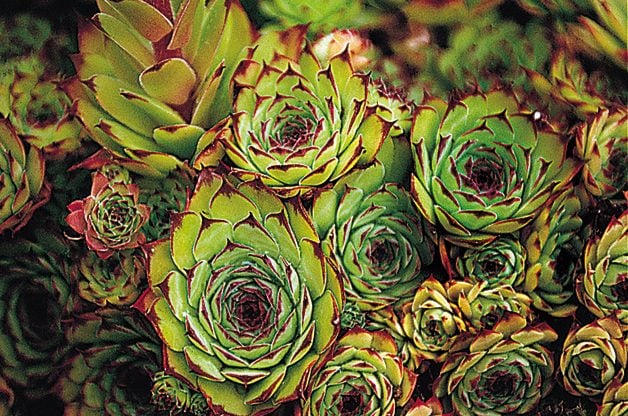
Hens-and-Chicks
(Sempervivum tectorum, Zones 3 to 8)
We love this tough plant with its clusters of rosette-shaped leaves. It seems to have limitless possibilities: Grow it in unusual shallow containers (like a pair of old high-heeled shoes!) or in rocky soil and challenging spaces. Newer cultivars are better than ever, so check them out at the garden center.
Why we love it: It’s very forgiving. It can go days without water, then it perks right back up once you remember.
Learn how, when and why you should divide perennial plants.

Yucca
(Yucca filamentosa, Zones 4 to 10)
If “more for less” is your motto, yuccas are a must-have. This enormous grower can get up to 5 feet wide, so instead of buying four or five plants for an area, fill the same space with just a couple of yuccas. The spiky leaves are a stunning focal point throughout the season, and tall white flowers bloom in midsummer.
Why we love it: The foliage lasts all season, so the blooms are just a bonus.
Check out these perennial plants with year-round bird benefits.

Yarrow
(Achillea species, Zones 3 to 9)
What’s not to love about yarrow? This selection on our low maintenance perennials list can grow in almost any condition. It blooms all the way until frost, and it offers lovely color both in the garden and as a cut flower. Now all you have to decide is which cultivar to grow! Moonshine has light-yellow blooms; Red Velvet offers a nice strawberry-pink alternative. Just pick one that is not too aggressive, and you’ll be on the road to success.
Why we love it: Though yarrow is sometimes considered a weed, the right cultivar is like discovering hidden treasure!
Be sure to never grow these poisonous and invasive plants in your yard.
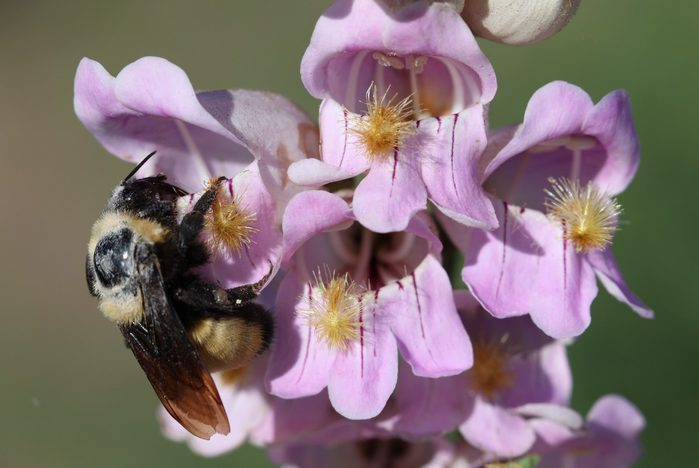
Penstemon
(Penstemon species and cultivars, Zones 3 to 8)
Don’t let the delicate tubular blooms fool you. Penstemon plant is tough, blooming early summer to fall. The signature perennial is mostly known for its scarlet flowers, but you can also find cultivars in purple, white and pink. For a distinctive look, try Husker Red, which sports reddish foliage and pinkish-white blooms.
Why we love it: With its red, tube-shaped blooms, it’s easy to see why it’s a hummingbird favorite.
These are the best flowering perennials that bloom all summer.

Ornamental Grasses
Never underestimate the power of ornamental grasses. They are the perfect garden backdrop, adding texture, color and fullness to any space, making them one of our favorite low maintenance perennials. Look for switchgrass (Panicum virgatum, Zones 3 to 9) for splendid fall color and also feather reed grass (Calamagrostis x acutiflora) for a stately sweep up to 5 feet. Ask local garden center experts for a native grass recommendation, since they’ll know what works best in your area and steer you away from invasive varieties.
Why we love it: It doesn’t matter what your style is, there’s an ornamental grass to fit any garden space.
Here’s when you should cut back ornamental grasses.

Lantana
(Lantana camara, Zones 8 to 11)
What a beauty this abundant bloomer is! While lantana is really considered a perennial only in warmer regions, you can keep this lovely plant going by using it in containers and then overwintering it indoors. If you’re successful, you’ll have a garden all-star for years to come.
Why we love it: The compact cluster of blooms has a tropical feel, and butterflies love it.
Next, check out these annual and perennial butterfly garden designs.
